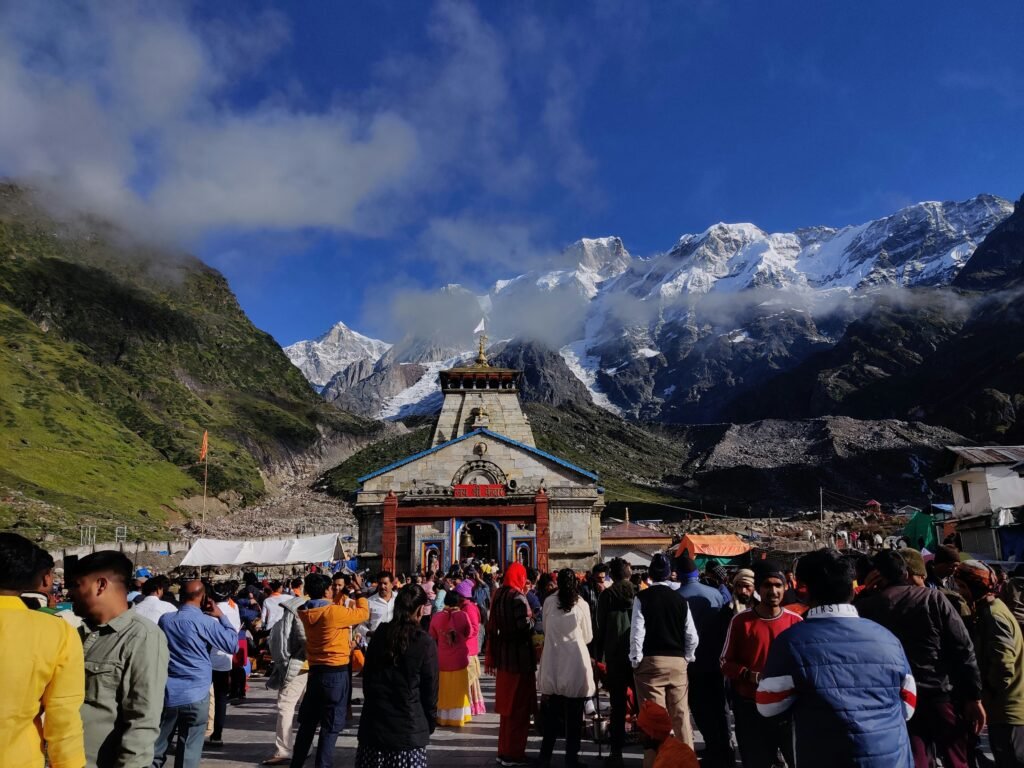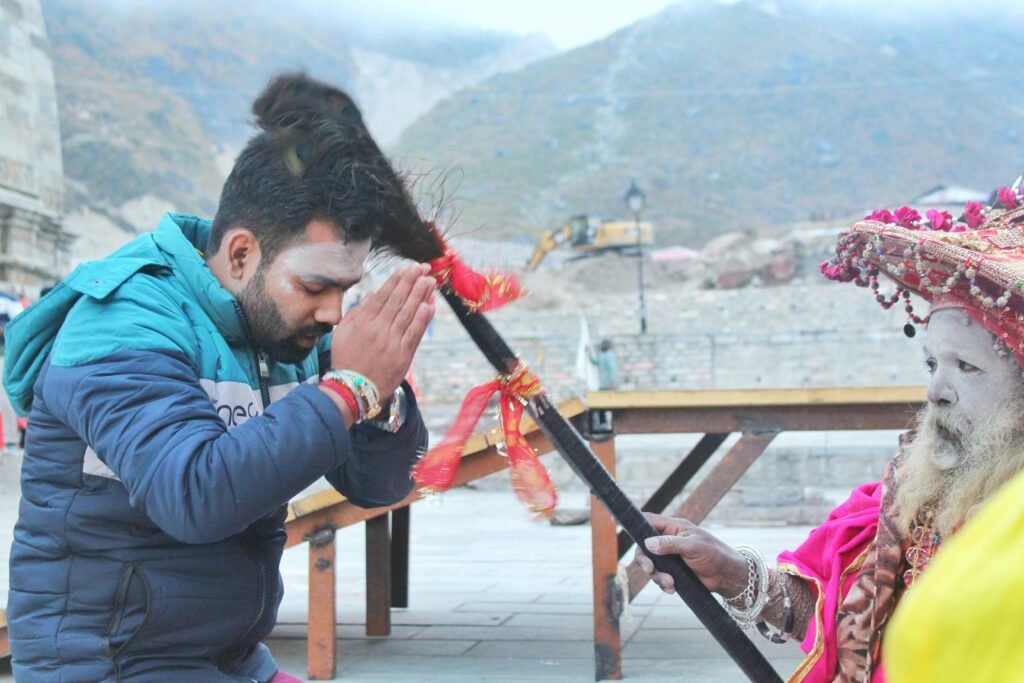Introduction to Kedarnath Temple
Kedarnath Temple, situated in the northern Indian state of Uttarakhand, stands as one of the holiest shrines in Hinduism. Nestled in the Garhwal Himalayas, this temple is dedicated to Lord Shiva and is part of the revered Char Dham Yatra, which also includes Yamunotri, Gangotri, and Badrinath. The geographical location of Kedarnath, at an elevation of approximately 3,583 meters above sea level, presents both a challenge and an awe-inspiring experience for pilgrims who embark on this spiritual journey.
The temple is historically significant and believed to have been established by the great sage Adi Shankaracharya in the 8th century CE. He is credited with revitalizing Hinduism and promoting the worship of Shiva across the Indian subcontinent. The foundation of Kedarnath Temple is steeped in mythology, strongly linked to the legendary Pandavas from the epic Mahabharata. According to tradition, the Pandavas, seeking penance for their sins in the Kurukshetra War, visited this sacred site to offer their prayers and seek blessings from Lord Shiva.
Kedarnath Temple has been a prominent pilgrimage destination for centuries, attracting thousands of devotees annually. The temple’s architecture showcases intricate stone carvings and a unique roof design, exemplifying the artistic prowess of the time. It is also noteworthy that the temple is accessible only for six months each year, as harsh winter conditions render the region inaccessible. Despite these challenges, the pilgrimage season sees an influx of devotees, illustrating the enduring devotion and sacred reverence associated with the temple. This pilgrimage not only serves as a means of spiritual fulfillment but also provides an opportunity for individuals to connect with nature and reflect on their faith amid the breathtaking Himalayan landscape.
Architecture and Structure of Kedarnath Temple

The architecture of Kedarnath Temple is a remarkable representation of traditional Hindu temple design, beautifully embodying the spiritual essence and cultural heritage of the region. Constructed primarily using local stone, the temple showcases intricate stone carvings that depict various deities, animals, and celestial beings. These carvings not only highlight the artistic craftsmanship of the time but also serve a spiritual purpose, inviting devotees to connect with the divine through visual representations. The attention to detail in these sculptures is indicative of the rich artistic traditions that have flourished in this part of India.
The temple’s sanctum sanctorum, known as the Garbhagriha, is a significant architectural feature, housing the revered idol of Lord Kedarnath. The sanctum is designed to accommodate the natural contours of the rocky landscape, which exemplifies how the temple’s architecture harmonizes with its surroundings. This respectful adaptation reflects a broader philosophy within Hindu architecture that seeks to create spaces for worship deeply integrated with nature.
The structure is built in the typical North Indian style, characterized by its pyramid-like roof that is both functional and aesthetic, allowing for resilience against the harsh Himalayan weather. The use of granite stone not only provides durability but also helps to maintain a stable internal temperature, crucial in an environment known for extreme weather conditions. Furthermore, the design of the temple facilitates effective drainage, preventing water accumulation during the heavy monsoon seasons.
Overall, the architecture of Kedarnath Temple stands as a testament to the ingenuity of its builders, who managed to create a spiritual sanctuary amidst the challenging landscape of the Himalayas. By blending intricate design with practical necessities, Kedarnath Temple has become a lasting symbol of faith and artistic achievement in the region.
Significance of Kedarnath in Hindu Mythology

Kedarnath Temple holds deep significance in Hindu mythology, especially in relation to Lord Shiva. Situated in the Himalayas, it draws thousands of devotees seeking spiritual fulfillment. The temple is dedicated to Lord Shiva, who is worshiped here in his form as Kedarnath. It stands as a symbol of faith and devotion.
According to the Mahabharata, the Pandavas performed intense penance at Kedarnath after the Kurukshetra war. They sought redemption for their sins, which highlights the temple’s role as a spiritual cleansing site. After their penance, the Pandavas met Lord Shiva, further emphasizing the temple’s divine status.
The temple also appears in sacred texts like the Puranas. These scriptures describe Lord Shiva as a protector and savior, solidifying the temple’s spiritual relevance. The majestic location of Kedarnath in the Himalayas enhances its sense of divinity, making the journey not just physical but spiritual.
For many devotees, visiting Kedarnath is a deeply personal pilgrimage, rooted in the rich myths and legends that surround the temple. The connection between its geography, historical significance, and spiritual beliefs creates a powerful experience. This sacred place serves as a living testament to the enduring faith in Lord Shiva.
Overall, the stories and traditions tied to Kedarnath Temple make it a vital destination for those seeking divine blessings.
Visiting Kedarnath: Tips and Travel Guide

Embarking on a spiritual journey to Kedarnath Temple requires careful planning to ensure a seamless experience. The best time to visit Kedarnath is between April and November, as the temple remains open during these months, offering pleasant weather and favorable conditions for pilgrims. During this period, the Kedarnath valley blossoms with vibrant flora, enhancing the overall spiritual ambiance.
Travel options to Kedarnath include road, rail, and air. The nearest major city is Rishikesh, which serves as a gateway to Kedarnath. Buses and taxis are available for the 220-kilometer drive to Gaurikund, the starting point of the trek to the temple. For those seeking a more adventurous route, trekking from Gaurikund to Kedarnath is a popular option, covering approximately 16 kilometers. Helicopter services are also available, providing a swift and scenic alternative for those who prefer not to trek.
Accommodation is readily available in Kedarnath, ranging from budget lodges to more comfortable guesthouses. Pilgrims are advised to book their stay in advance, especially during peak season, to ensure a restful environment after a long day of traveling or trekking.
While visiting Kedarnath, it is essential to explore the surrounding region, which boasts beautiful landscapes and significant cultural sites. Nearby attractions such as the Bhairav Temple and the scenic views of the Himalayan mountains enhance the pilgrimage experience. Travelers should also be mindful of safety concerns, particularly when trekking at high altitudes. It is advisable to acclimatize, stay hydrated, and consult with local guides regarding weather conditions.
In addition to physical preparedness, understanding cultural etiquette is vital. Respecting local customs, dressing modestly, and refraining from loud behavior is essential while visiting this sacred site. By taking these tips into consideration, pilgrims can ensure a fulfilling visit to Kedarnath Temple, which is surrounded by the serene beauty of the region.






